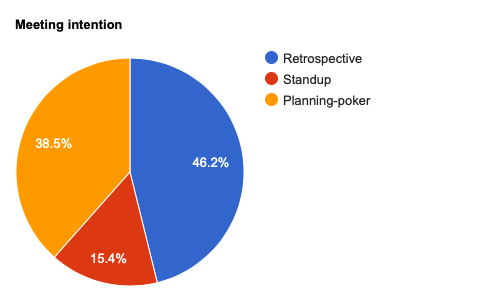
Team O’clock Onboarding performance

Onboarding enhancements performance, 1 month in
Almost a month ago we improved the onboarding experience, aiming to drive more people into trying out one of the offered meetings retrospective, standup, or planning poker session.
A TL:DR; version of the story reads SUCCESS with an improvement of +33% more people in trial performing a meeting! That’s going from 9.26% performing a meeting to 44.93% today! Keep reading to see more interesting finding and metrics on the process.

Initial assumption and actions taken
The basic assumption we made performing these changes was that people miss their initial intention and would like the platform to nudge them into proceeding with a meeting action.
The initial percentage of people creating an account on Team O’clock to performing a meeting was 9.26%. This has been the core percentage we wanted to improve!

That’s why the improvements were focused on the first experience with 3 in-app actions:
Getting the person’s intention by asking What’s the main meeting they are trying out Team O’clock right after the sign up phase.
When the person launched on Team O’clock dashboard — the first screen — have a call to action section for the selected meeting.
A quick walkthrough video, when clicking to see more details on the call to action section.
You can see how each action works either reading the previous post, or trying out Team O’clock for yourself.
Metrics, 23 days in
After releasing the above improvements we now see a great improvement on the core percentage! As you can see on the updated funnel below we have gone from 9.26% to 44.93% of trials with a meeting performed! That’s a dramatic jump x4.8 UP in trials with a meeting performed!
At this point, we can call the specific onboarding iteration a success. We will need to re-evaluate the funnel performance in time to ensure that this is a persistent behaviour and focus on other steps of the trial-funnel.
Due to the actions taken, we do hold more interesting data to share regarding trialer intentions joining Team O’clock, like what’s the most favourable meeting type among the three (retrospective, standup, planning poker)? And is that initial intention — answering a question after signup — reflects to action?
Follows a graph counting the intention of people joining Team O’clock.

From the above graph, we see that people do consider retrospective and planning poker sessions as more important for using a tool like Team O’clock. It’s worth noting that both meetings are tools towards team alignment and growth.
Now let’s see if that initial intention has followed through with respecting action. How non-demo meetings are disseminated from companies in trial?

As the graph above displays, the intention is followed through by respecting action, with Retrospective leading by more than 50% of meetings. One more thing to note here is the absence of Standup meetings at least for the first 30 days of a trial.
The trial-value funnel
The trial-value funnel focus is on exposing Team O’clock services at its best! The focus is solely on that and NOT on securing a conversion. That’s why the whole funnel consists of the following steps:
People in trial having any activity on the Team O’clock interface, like entering the dashboard or a Team O’clock meeting. This is to measure initial engagement with the platform.
People in trial that performed one of the Team O’clock meetings.
People in trial that had at least two meetings while in trial, as an indicator of building a habit.
Evaluation & next steps
As mentioned above, the performed onboarding improvements are considered a success against the set goal of making more people in trial test out their intended Team O’clock meetings. Besides that, there were some interesting findings that will need further investigation, like:
Standup meeting poor performance during the trial period. On our side we will need to try and promote the standup value offered so that people at least try it out earlier! Based on our overall metrics, standup does perform well with steady teams, yet it seems that people are exposed to the standup value offered later in their journey.
Shift focus on other steps of the trial-value funnel to improve them as well. After improving the performance of the specific funnel step — related to performing a meeting — it is obvious that Team O’clock needs to improve the remaining steps, having to do with 1) People actually joining the trial, that’s the top of the funnel, 2) People and teams creating a habit out of the meetings by having more than one meetings while in trial.
If you enjoy these updates please consider following this channel. Also, if you haven’t tried Team O’clock yet for your agile meetings, give it a try!

More articles to check

Assist your team's growth with our partnership program:








